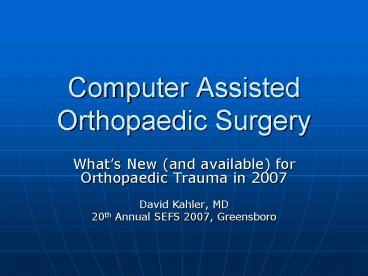Computer Assisted Orthopaedic Surgery PowerPoint PPT Presentation
1 / 58
Title: Computer Assisted Orthopaedic Surgery
1
Computer Assisted Orthopaedic Surgery
- Whats New (and available) for Orthopaedic Trauma
in 2007 - David Kahler, MD
- 20th Annual SEFS 2007, Greensboro
2
Advances in Navigation
- CT-based navigation (early 1990s)
- Fluoroscopic (Surgical) Navigation (1999)
- Tracking of individual fragments (2001)
- Fracture reduction software (2003)
- Improved software dedicated femoral nailing
application (2004-2005)
3
C-arm (fluoroscopic) navigation
- Images are obtained in OR
- C-arm, patient, and instruments are tracked by
camera and computer - New images easily obtained
- Best CAOS application for trauma (does not rely
on preop or intraop CT)
4
(No Transcript)
5
(No Transcript)
6
Audience Response QuestionImage guided surgery
(surgical navigation) is a useful tool during
fixation of femoral shaft fractures.1.
Agree2. Disagree3. Undecided
7
Barriers to Acceptance
- Cost of systems (Not available at my hospital)
- Additional O.R. time for fixation of trackers and
intraop planning steps after obtaining images - Increased equipment and line-of-sight issues
- Inertia
8
Developing Solutions to the Challenges
9
Conquering Inertia through Education
- AO MIO/CAS courses, Davos 05 and 06
- AAOS ICL and OTA Symposia 04-06
- BrainLAB Masters course, Las Vegas, February 2007
- AO Faculty Development Course, West Chester,
March 2007 - AO MIO Course (first US AO course) late 2007
- AO CAS course, Davos 2007
10
Basic advantages of navigation for intramedullary
nailing
- Stored images in two planes
- Improved
- Less total fluoroscopy time
- Stops irradiation of surgeon
- Allows the surgeon to exactly match the anatomy
of the injured side to the other side
11
Case Report
- A 29 year old male with multiple lower extremity
diaphyseal injuries and an acetabular fracture
following ejection from a motor vehicle - Bilateral femoral shaft fractures
- Right tibial/fibular shaft fractures
- Left anterior column acetabular fracture
12
(No Transcript)
13
(No Transcript)
14
OR night of injury
- Patient initially stable, lactic acid 1.8
- Plan to stabilize diaphyses and temporize
acetabular fracture - Right leg stabilized with retrograde IM femoral
nail and antegrade tibial nail - Patient became hypothermic and hypotensive, right
femur externally fixed and procedure terminated.
15
(No Transcript)
16
(No Transcript)
17
(No Transcript)
18
(No Transcript)
19
Post-op
- Pelvic angiography negative, but profunda femoris
artery found to be disrupted on left, embolized
20
(No Transcript)
21
(No Transcript)
22
New problem malrotation
- Patients right lower extremity noted to be
severely externally rotated, and left leg
internally rotated - Is right tibia or femur malrotated?
- Is left femur externally fixed in internal
rotation? - Are all three bones malrotated?
23
Which is the healthy side?
24
Right Femur
- Appeared to be well-reduced
25
(No Transcript)
26
(No Transcript)
27
Tibia
- Spiral fracture malrotated?
28
(No Transcript)
29
Left femur
- Difficult to determine rotation due to transverse
pattern with butterfly fragment
30
(No Transcript)
31
Options for Definitive Management?
32
Plan
- Decision made to match anteversion of both femora
during left femoral IM nailing, and then correct
tibia if necessary - Right femoral anteversion measured at six degrees
intraoperatively using C-arm images - Navigation used for left femoral nail for
starting point and reduction, including
correction of rotation
33
(No Transcript)
34
(No Transcript)
35
(No Transcript)
36
(No Transcript)
37
Results
- Femur had been externally fixed in 27 degrees of
antetorsion - Corrected to 6 degrees at time of nail insertion
- Tibia remained externally rotated, and was
corrected by rotational reduction and revision of
distal locking screw
38
(No Transcript)
39
(No Transcript)
40
(No Transcript)
41
(No Transcript)
42
(No Transcript)
43
(No Transcript)
44
(No Transcript)
45
Result
- Both legs healed in anatomic alignment
- In this case navigation proved useful in both
diagnosing and correcting a problem with
malrotation following fracture fixation - How many femora do we leave malrotated at the
time of surgery? - 30 have more than 15 degrees malrotation by CT
- Internal rotation causes measurable gait
disturbances with as little as 10 degrees
46
Future Aspects
- Matching of well leg now available (restoration
of normal length and rotation) - Navigated reduction devices
- Visualization of implants
47
Integration of MIPO
- Current software allows rudimentary use of
navigation tools (pointer, drill guide) during
subcutaneous plating applications - New application specific software will allow
surgeon to accurately place specific implants
using minimally invasive technique (distal
femoral LCP)
48
(No Transcript)
49
(No Transcript)
50
(No Transcript)
51
(No Transcript)
52
(No Transcript)
53
Room For Growth
- New Hardware integrations
- Hardware specific techniques.
- LCP/DCP integration
- Nail integration
54
(No Transcript)
55
(No Transcript)
56
(No Transcript)
57
(No Transcript)
58
Navigation in 2007
- New products and software workflows
- Educational programs
- Should be a banner year for adoption of
navigation as a routine tool in fracture care

